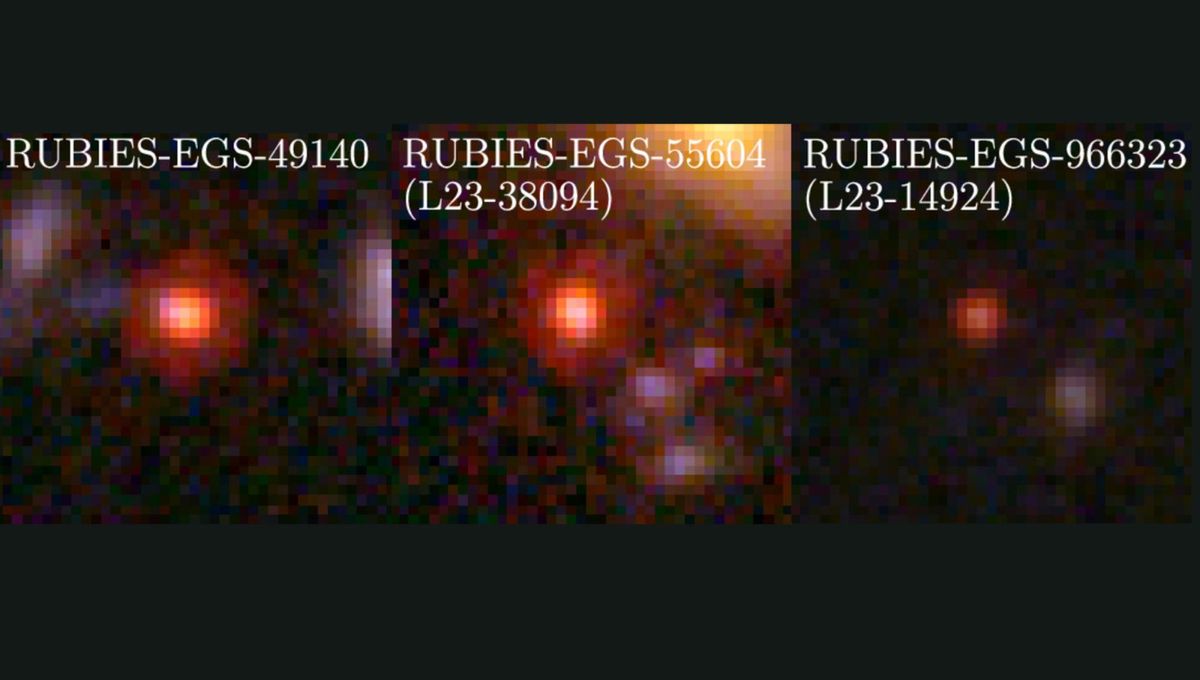
The JWST has allowed astronomers to peer back further into the past than any other infrared or optical telescope, seeing infrared light that was emitted by distant galaxies just 300 million years after the Big Bang.
With the infrared telescope, we were hoping to learn more about the formation of galaxies, as well as clear up mysteries about how supermassive black holes became so large. But we have been thrown a few surprises as we look further back into the past.
One such surprise is the tiny, bright red dots of light that appear to be dotted throughout the early universe, around 600-800 million years after its birth. When they were first detected and analyzed, astronomers believed they could be massive galaxies. But this was at odds with how cosmological models expect galaxies to form – as small clouds of dust and stars that grow larger over long periods of time.
“The revelation that massive galaxy formation began extremely early in the history of the universe upends what many of us had thought was settled science,” Joel Leja, assistant professor of astronomy and astrophysics at Penn State, said in a statement following early observations. “We’ve been informally calling these objects ‘universe breakers’ – and they have been living up to their name so far.”
Of course, seeing objects that could upend our models of galaxy formation, the team wanted to be sure of what they were seeing, and aimed to take spectrum images of these galaxies to get a better idea of the distance of the galaxies, what the galaxies are made of, and how massive they truly are. Following that analysis, they have found these objects are indeed pretty weird, and in several ways.
First off, despite being only 600-800 million years old, the galaxies appear to be packed with ancient stars, aged hundreds of millions of years old. As well as the oddity of their formation, this means the team was looking at the earliest signatures of old starlight ever found.
“These early galaxies would be so dense with stars – stars that must have formed in a way we’ve never seen, under conditions we would never expect during a period in which we’d never expect to see them,” Leja said in a statement following the latest work. “And for whatever reason, the universe stopped making objects like these after just a couple of billion years. They are unique to the early universe.”
But there are more mysteries to solve. The team estimates that the galaxies have surprisingly large supermassive black holes at their centers, between 100 and 1,000 times larger than Sagittarius A* at the center of the Milky Way. That’s far too big for the galaxy surrounding it. If the galaxy were compressed to the size of the Milky Way, the team says that the nearest star would be just outside our Solar System, and the supermassive black hole at the center would be just 26 light-years away from Earth, visible as a huge pillar of light.
“Normally supermassive black holes are paired with galaxies,” Leja added. “They grow up together and go through all their major life experiences together. But here, we have a fully formed adult black hole living inside of what should be a baby galaxy. That doesn’t really make sense, because these things should grow together, or at least that’s what we thought.”
Supermassive black holes we see in the nearer (more recent) universe are, as the name would suggest, pretty big. Cosmologists would like to know how these supermassive black holes, which are found at the center of most (but not all) galaxies, came to be such a large size.
There have been a number of theories, including mergers of black holes, and that the black holes grew through feeding. These early black holes, and others discovered by the JWST, appear to be too large to be explained by these ideas, and much larger than cosmologists had been expecting in comparison to the galaxies surrounding them.
One idea, which is perhaps becoming more favorable in light of recent observations, is “direct collapse” or “heavy seed” black holes. Usually, to get a stellar mass black hole (in the current age of the universe), a star undergoes collapse. With heavy seed black holes the idea is that supermassive black holes would have started out at around 10,000 to 100,000 solar masses, through the direct gravitational collapse of gigantic gas clouds, without an intermediate stellar phase.
There are a few things that could make this scenario unlikely too. The gas cloud would need to collapse without fragmenting and forming clumps as it does so, though astronomers have suggested that this could be prevented if the cloud is heated by nearby young stars in pre-galactic gas disks, or if the gas cloud was moving at supersonic speeds in “flows” in the early universe, allowing it to grow for longer, until the gravity is sufficient to start the cloud’s collapse into a seed black hole.
It is currently difficult to distinguish the precise mass of the supermassive black holes at the center of these galaxies from the stars surrounding them. More observations are planned, taking spectra over a longer period of time, to get a better picture.
“It’s very confusing,” Leja added. “You can make this uncomfortably fit in our current model of the universe, but only if we evoke some exotic, insanely rapid formation at the beginning of time. This is, without a doubt, the most peculiar and interesting set of objects I’ve seen in my career.”
The latest study is published in The Astrophysical Journal Letters.
Source Link: "Universe Breakers": Unexplainable Bright Red Dots Found In The Early Universe